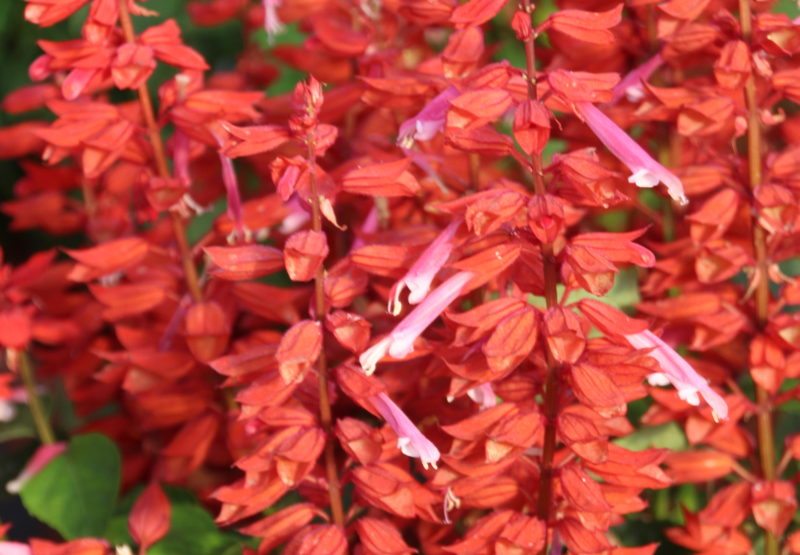
Culture Report: Salvia Grandstand Series
The first commercial Salvia splendens varieties were tall, thin and lacking the colorful punch of today’s selections. Breeders saw the potential of this plant and soon developed varieties that were much more compact with an expanded color palette. Seed-propagated forms have long been a popular bedding plant staple for the home garden and landscape. These compact varieties finished well in cell packs for growers, but cycled color after the initial bloom and required “deadheading” to promote new flowers.
Recent breeding efforts have resulted in larger growing, longer blooming forms with an exceptional color range. These new varieties are ideal for the home gardeners’ planters and mixed containers.
GreenFuse Botanicals introduced Grandstands, a vegetative series of Salvia splendens, at the 2015 California Spring Trials. The series is stout, with full flowers at finish, but plant height is well within the standards that permit growers to ship efficiently on racks. For the retailer, the sturdy plants will hold up well during shipping and handling. The Grandstand salvia matures at a height of 12 to 18 inches with a spread of 12 to 14 inches.
GreenFuse has found there is little, if any, day length response for flowering. In our California trials, we will have plants in full color mid-February and by mid-March in the Midwest and East. Grandstand salvia will not cycle out of color and does not require removal of spent flowers in order to remain in bloom.
Salvia splendens will perform best in full sun and will hold up to hot, humid conditions, thus ensuring summer-long color and performance. They are pollinator friendly, an increasingly important dimension in today’s garden schemes. Hummingbirds and butterflies will find salvia Grandstand irresistible. Flowering continuously until hard frost, Grandstand varieties take center stage in any garden landscape with their sturdy plant structure and continuous color.
New colors for 2016 are a dramatic Blue Bicolor, soft-toned Salmon and Red Pink Lipstick, a vivid red and rose-flowered variety, bringing the total number in the series to six.
Propagation
Salvia Grandstand are available as unrooted cuttings or rooted liners. Unrooted cuttings will root easily in four to five weeks (25 mm liner). The optimal root zone temperature is 68 to 70° F until roots are visible. At that point, reduce misting and provide slightly cooler temperatures so internodes and stems do not stretch. Next, begin feeding at 50- to 75- ppm nitrogen using low phosphorus, calcium nitrate-based fertilizers to eliminate soft, stretched growth (EC of 0.7 to 0.8). A preventative fungicide spray at day 14 will keep plants clear of any foliar diseases.
Finishing
Use a well-drained soil mix with a pH of 5.8 to 6.3. After transplant, slightly warmer temperatures will promote rapid growth and root development. After seven to 10 days, the optimal temperature range is 65 to 75° F days and 58 to 62° F nights. Enhance plant quality of finished plants with cooler night temperatures of 55 to 58° F. A sudden and extreme drop of temperatures will cause “flagging” of leaves.
Scheduling Media and Fertilization
Keep soil moderately moist at all times. Dry soil conditions may distort leaves or create brown spots along the leaf margin, and, in extreme dry conditions, can defoliate the lower portion of the plant. Fertilize at 100- to 200-ppm nitrogen every watering, using a balanced feed to maintain foliage color.
Fertilizers containing a low percentage of ammonium and urea will lower the risk of tall plants, thin growth and poor quality plants. Salvia are sensitive to an elevated salt level in the soil. Occasional clear water irrigations will help eliminate salt build-up. A dull grey leaf color, drooping leaves and marginal leaf browning may be an indication of elevated salt levels or excessive drying. An optimal EC for finishing is 0.8 to 1.2.
Pinching and Growth Regulators
Pinch at transplant or within five days after transplant, leaving three to four nodes below the pinch. PGR applications early in crop sequence will finish plants at an ideal height. Spray applications of B-Nine or Sumagic are effective without concern of plants not growing after garden planting. Drench applications using Bonzi at low rates are also effective.
Insects and Diseases
Whitefly and aphids are the most prevalent and intrusive pests. Thrips and spider mites can occasionally be a problem as well, and slugs and snails will also feed on salvia. Alternaria leaf spot and powdery mildew are the most common leaf diseases. Rhizoctonia, Pythium and Phytophthora are the primary root/soil disease concerns. Scouting for any issues along with preventative drenches and sprays will help prevent most pest infestations and diseases.



 Video Library
Video Library 




















